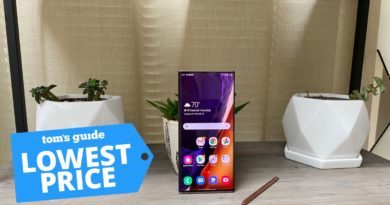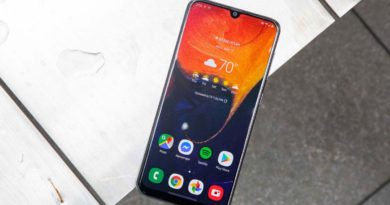Best phones with IR blasters
Remote controls are so old school. So, it’s perhaps no surprise that people are looking for the best phones with IR blasters. These small components mimic infrared-remote controls and effectively turn your smartphone into a universal remote.
Unfortunately, while IR blasters were once a common feature for some phone makers, they’ve fallen by the wayside in recent years. Samsung stopped embedding them in their flagships with the Galaxy S6, for example. That said, some Chinese manufacturers, like TCL, Huawei and Xiaomi, still see value in IR blasters and continue to incorporate them to this day.
All of this to say, if you’re desperate for a smartphone that can replace your living-room remote, there aren’t many easy choices. Nevertheless, these are the ones that rise to the top.
What are the best phones with IR blasters?
What was once a popular feature is now an uncommon, niche one. Once upon a time, a vast majority of the best Android phones also had IR blasters embedded within them. Combine that with a proper remote control app — either one that came pre-installed onto the phone or third-party software you could download off the Google Play Store — and you had the holy grail of all universal remotes at your disposal.
Times have changed. Today, not one flagship phone on sale in North America features an IR blaster. Samsung and LG ditched them long ago, and Apple never believed in them to begin with.
In fact, there’s only one modern phone sold in the North America that has an IR blaster, and it happens to be a brand-new one — the just-released TCL 10 Pro. However, that $449 device is good, but not excellent, and so it likely won’t be the perfect choice for all users.
So what if you don’t want TCL’s midranger? You have two choices: Either pick up something really old — like the LG G5 — or import an international model of a modern device that will work on global networks, and isn’t sold domestically, like the Xiaomi Mi 10 Pro. (Fortunately, if you live in the U.K. you’ll at least fare a little better than your American counterparts, as some of these phones are actually sold there.)
In most cases, we’d recommend you actually stay away from an ancient device like an old Galaxy or LG handset simply because they’re too slow to use reliably anymore, and are missing out on critical security updates to ensure a safe and stable user experience. However, you may find it worth picking up one of these older models as a separate, second phone simply to use as a remote.
The best phones with IR blasters you can buy today
1. TCL 10 Pro
An affordable, new phone with an IR blaster
Display: 6.47-inch OLED (2340×1080) | CPU: Snapdragon 675 | Weight: 6.6 ounces | Battery size: 4,500 mAh
Impressive OLED display
Premium design
Strong battery life
Cameras are hit-or-miss
Gaming performance not the best
We were surprised but not totally shocked to find an IR blaster on the top edge of the TCL 10 Pro. TCL, after all, is originally a TV maker by trade, and this phone does pack a number of tricks borrowed from the company’s sets. Sure, you can use it as a universal remote, but the TCL 10 Pro also features a 6.47-inch AMOLED display powered by the firm’s Nxtvision engine for bold colors and contrast.
Admittedly, the Nxtvision software doesn’t make on-screen content look stellar in every context, but this is still a good panel, and certainly large enough to serve as a remote control when it needs to. We should also note we synced our TCL 10 Pro to a Panasonic LCD TV during testing, and both the pairing and act of actually using the phone as a remote could not have been easier.
Other highlights of the TCL 10 Pro include its powerful Snapdragon 675 chipset and quad-lens camera system, headlined by a 64-megapixel wide-angle rear shooter. It’s not a perfect budget phone — for our money, we’d rather have the new iPhone SE 2020 or the Google Pixel 3a. But if you absolutely need a smartphone with an IR blaster, and you don’t want to trudge down the hard route of importing or scrounging up something old, the TCL 10 Pro is your only choice.
Read our full TCL 10 Pro review.
2. Xiaomi Mi 10 Pro 5G
A good import buy for an IR-equipped flagship
Display: 6.67-inch OLED (2340×1080) | CPU: Snapdragon 865 | Weight: 7.34 ounces | Battery size: 4,500 mAh
The Xiaomi Mi 10 Pro 5G is as cutting edge a phone as you can expect to find with an IR blaster onboard. Powered by Qualcomm’s latest processor — the Snapdragon 865 — and a generous 12GB of RAM, the Mi 10 Pro’s nearly 6.7-inch OLED screen also benefits from a 90Hz refresh rate for increased responsiveness.
Other features of the Mi 10 Pro 5G include a quad-lens rear camera which packs the same primary 108-megapixel lens found in the Samsung Galaxy S20 Ultra, along with an in-display optical fingerprint sensor and superfast charging, whether you opt for 50-watt wired or 30-watt wireless. And, of course, this is a 5G phone, meaning it can take advantage of faster data speeds.
As with any import phone, however, you’ll want to make sure the Mi 10 Pro 5G will work with enough of the bands your carrier relies upon for service, before taking the plunge on this rare IR blaster-equipped flagship. At the time of writing, Giztop is carrying the Mi 10 Pro 5G for a reasonable $749 and will ship the device to U.S. customers.
3. Huawei P30 Pro
The final Huawei flagship with Google apps
Display: 6.47-inch OLED (2340×1080) | CPU: Kirin 980 | Weight: 6.77 ounces | Battery size: 4,200 mAh
Versatile cameras
Long-lasting battery
Strong performance
Limited availability in U.S.
Frustrating, dated software
The Huawei P30 Pro is a well-rounded flagship with a great camera — not to mention quite possibly the last Huawei flagship we may ever see with Google apps pre-loaded from the factory. It also sports an IR blaster, which its cheaper and smaller sibling, the Huawei P30, does not.
The P30 Pro isn’t the fastest flagship anymore, especially given that its Kirin 980 was already a bit behind the beat compared to Qualcomm’s high-end chipsets even when it launched in mid-2019. It also doesn’t have the prettiest display, or the most intuitive software. But the P30 Pro’s quartet of lenses make this handset an exceptionally versatile mobile camera, capable of expansive ultrawide shots or impressively-crisp photos captured with the phone’s powerful 5x optical zoom.
The newer Huawei P40 Pro may be on the market now, but given its omission of Google services, we much rather recommend importing the P30 Pro instead — it’s simply a better experience, and will afford you access to the apps you need.
Read our full Huawei P30 Pro review.
4. Huawei Mate 10 Pro
One of the last U.S.-sold flagships with an IR blaster
Display: 6-inch LCD (2160×1080) | CPU: Kirin 970 | Weight: 6.28 ounces | Battery size: 4,000 mAh
Class-leading battery life
Strong performance
No wireless-charging support
Frustrating user interface
A little old
The Huawei Mate 10 Pro is a glimpse at an alternate reality for the beleaguered Chinese phone maker; a reality that demonstrated what might have been possible had the company been permitted to sell its smartphones in the U.S. as it originally intended to. The Mate 10 Pro was officially sold in the U.S. direct from Huawei, but not through any carriers, and cost $799 when it went on sale in the early part of 2018.
For that price, you’d get much more than just an IR blaster. The Mate 10 Pro benefited from a dual-lens camera system that packaged an ultrawide optic with a conventional wide-angle one for expansive landscapes. With a 4,000-mAh battery, this phone lasted far longer on a charge than any of its contemporaries at the time, too.
Overall, the Mate 10 Pro made for a solid effort from Huawei and a looker of a high-end handset, though it simply wasn’t meant to be. These days, you can nab a unit for less than $400, and this is actually one of the rare old devices on this list we wouldn’t shy away from using in 2020 as a daily driver.
Read our full Huawei Mate 10 Pro review.
5. LG G5
A quirky old flagship on the cheap
Display: 5.3-inch LCD (2560×1080) | CPU: Snapdragon 820 | Weight: 5.61 ounces | Battery size: 2,800 mAh
Neat modular design
Solid ultrawide camera
Below-average battery life
Heavy-handed software interface
Extremely old
Released in 2016, the LG G5 stands as one of the final flagship devices from a prominent, large-scale phone maker to tout an IR blaster. But the LG G5 was quirky for other reasons too; it was modular and had a removable battery, which made for a pretty cool distinction four years ago. Unfortunately, the 2,800-mAh battery onboard (respectably sized by 2016 standards, it must be said) didn’t last long enough on a charge.
Today, the LG G5 can be found on Amazon for less than $200, which is either a decent price by modern smartphone standards, or far too expensive for a universal remote, depending on how you look at it.
Read our full LG G5 review.
How to choose a phone with an IR blaster
This is one of those cases where you actually don’t have a ton of choice. If you’re in the market for a relatively-inexpensive phone and the TCL 10 Pro fulfills your basic needs, it’s worth taking the plunge on that $449 device. But if you want something powerful, you’ll have to look to importing a newer device from overseas.
IR blasters generally function the same on all phones, so it’s simply a matter of determining which imported handset will best support your carrier’s network. Always opt for the international versions of GSM unlocked handsets, as these models can connect to the widest range of bands that carriers employ all over the world, and stand the best chance of working where you live. Do note that only GSM carriers, such as AT&T and T-Mobile, are fully-equipped to take on an internationally-sold, GSM-unlocked phone; Verizon and Sprint are more locked down, and likely won’t sync up with an imported device.
If you’re interested in snagging an older phone, just be aware of what you’re getting yourself into. Any potential software flaws you run into likely won’t have fixes. Battery life on a charge could be lacking too, especially if you purchase a device secondhand, after it’s endured some normal wear-and-tear.
How we test smartphones
Every smartphone Tom’s Guide reviews is tested for several days in real-world use cases and benchmarked with a gamut of performance-measuring apps. In terms of performance, we used Geekbench 5 to measure overall speed and GFXBench to measure graphics performance.
We also use our own video editing test in the Adobe Premiere Rush app to see how long it takes to transcode a clip, which we run on both Android phones and iPhone to compare performance.
We use a light meter to ascertain display quality data, like brightness and color accuracy, and our proprietary battery test determines longevity on a charge by continuously loading live webpages over a 4G or 5G network. We set each phone to 150 nits of screen brightness and try to use T-Mobile’s network each time in order to achieve comparable results across phones.
Lastly, we explore the software, test gaming performance and conduct live camera comparisons with rival handsets — and each of these factors play a part in our comprehensive verdict.

